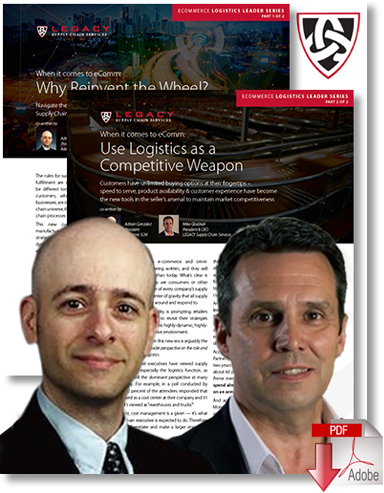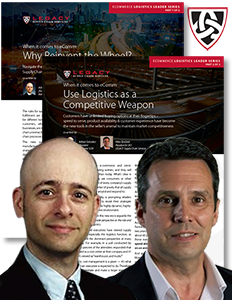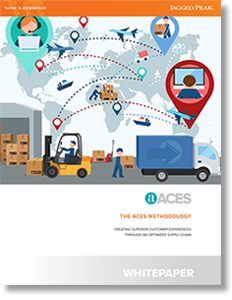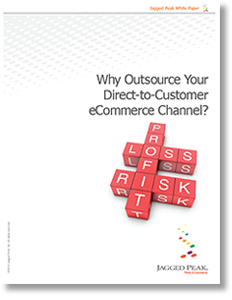Navigating Ecommerce with Your Existing Supply Chain Relationships & Capabilities

The rules for success in e-commerce and omnichannel fulfillment are still being written, however, you can minimize the risks and costs of scaling your operations, and get to market faster, by leveraging your existing network, resources, and relationships to their fullest potential.
When it comes to eCommerce Why Reinvent the Wheel?
The rules for success in e-commerce and omnichannel fulfillment are still being written, and they will likely be different tomorrow than today.
What’s clear is that customers, whether they are consumers or other businesses, are now the center of every company’s supply chain universe; they are the center of gravity that all supply chain processes must revolve around and respond to.
This new customer-centric reality is prompting manufacturers and retailers of all sizes to revisit their strategies and capabilities to succeed in this highly dynamic, highly-uncertain, and highly competitive environment.
In March 2017, for example, Walmart pulled the plug on building a 1.2-million-square-foot distribution center in Merced, CA. Originally proposed in 2005, the planned facility no longer makes sense because “the nature of retail has changed since the project was announced 12 years ago,” said Delia Garcia, Walmart’s senior director of communications, as reported in the Merced Sun-Star.
Ms. Garcia added: “We are innovating our business. We are transforming our business. We are investing heavily in e-commerce, and our e-commerce capability.”
The Nature of Retail has Changed Since 2005
Twelve years ago, according to the U.S. Department of Commerce, e-commerce sales totaled $91.4 billion and represented just 2.5 percent of total retail sales in the United States; in 2016, e-commerce sales reached $394.9 billion and accounted for 8.1 percent of total retail sales.
In terms of overall growth rates, total retail sales grew just 2.9 percent in 2016 compared to 2015, while e-commerce sales grew over 15.1 percent!
This rapid growth, coupled with more demanding customer expectations (such as faster, more reliable, and free delivery), is having a ripple effect on supply chain and logistics processes, networks, and technology requirements.
Simply put, as customers expect faster, cheaper, and better service, finding the right balance between inventory, transportation, and labor costs are more complex than ever.
There are many questions and factors companies must consider when determining the right e-commerce & omnichannel fulfillment strategy. Here are just a couple:
Do we build dedicated fulfillment centers for e-commerce or have all of our fulfillment operations under one roof?
Many manufacturers and retailers have started down one path only to change course later as the scale and scope of their operations changed. In many cases, the catalyst for change was driven by rising inventory costs (too much inventory at some locations, not enough at others), rising transportation costs (because you’re too far away from customers or need to make multiple shipments per order), and/or poor service levels.
Back to Walmart, the retailer is changing course and building new distribution centers and channels for e-commerce. As reported in the Wall Street Journal, when a customer orders different products today from Walmart “- say, shampoo, a toy and an Apple Inc. iPad - [it] may have to be filled from three separate locations. The goal of Wal-Mart’s new centers is to provide a single place stocked with a wide variety of products to get shipments collected and sent faster.”
Should we collaborate with our suppliers and have them drop-ship more orders?
A research report published in January 2017 by Retail Systems Research (RSR) in cooperation with SPS Commerce showed that 40 percent of the 563 companies surveyed (including retailers, manufacturers, distributors, and logistics service providers) plan to increase the number of drop-ship vendors in 2017, while logistics service providers expect large increases in drop-ship relationships over the next three years.
Home Depot, Macy’s, and Pier 1 Imports are among the growing number of retailers that are increasing their drop-shipping activities.
But the biggest question of all, particularly for companies that are just getting started, is this: How do we scale our e-commerce and omnichannel fulfillment capabilities while minimizing risk, cost, and time-to-market?
Rather than completely re-inventing the wheel, many companies are leveraging their existing network, resources, and relationships, especially with logistics service providers, to address this challenge.
The Answers to your E-Commerce Questions May Already Exist
“Third-party logistics providers are becoming increasingly important [in e-commerce],” states a September 2016 report by Prologis. “Outside expertise can be critical. Many of our customers operating e-fulfillment are third-party logistics providers conducting order fulfillment on behalf of retailers.
This is especially the case for our mid-sized and smaller size categories. E-fulfilment is a complex operation. For online retailers, this outside expertise can be a crucial value-add at a time when topline growth might be scaling quickly.”
Where do you begin? Start with your current third-party logistics (3PL) partners because they already possess two critical attributes for success: they have already earned your trust by successfully managing your traditional fulfillment operations and they are already very knowledgeable about your products and supply chain.
Mike Fahey, Vice President of Operations for Haier America states “you need the right partner to get it done… It has always been my belief that partnering with the right 3pl is key to success.
Hoping that you have the right partner through their culture or experience in certain areas, as well as sharing responsibility in the operations are elements that I look for. We are an E-Comm solution for many of the big box companies now and that continues to grow - as do the requirements from big box companies themselves. We have partnered with our 3pl to improve the processes around E-Comm fulfillment operations to drive cost out while increasing the turnaround time.
The pressure will continue to grow as E-Comm continues to grow, and more companies are pointing in this direction. With my 3pl, we will benchmark companies doing this process well, look to automation and process improvement to drive this part of the business.”
Trust and knowledge: it often takes years to acquire both, so rather than start from scratch with another 3PL you haven’t worked with before, reach out to your existing partners to see if they are able to meet your e-commerce and omnichannel fulfillment needs too.
There are other key ingredients for success when deciding whether your current 3PL can help address your Ecommerce challenges:
Flexible and Modern Technology: Various software applications and technologies play an important role in e-commerce and omnichannel fulfillment, including supply chain visibility (especially real-time visibility to inventory across the network), distributed order management (DOM), transportation management (including drop shipping), warehouse management and automation, and business intelligence and analytics. Whether these systems are yours or provided by your 3PL partner, it’s imperative that they are flexible and easy to configure in order to quickly adapt to ever-changing business processes and requirements.
Cultural and Strategic Alignment: Do you and your 3PL partner share the same values and commitment to continuous improvement? Is your 3PL’s strategy for growth and investment aligned with yours, especially as it relates to e-commerce and omnichannel fulfillment? The answer should be ‘yes’ to both. Ideally, you and your 3PL partner should develop a shared vision statement that aligns with the objectives and desired outcomes of the end customer, which in many cases is the consumer.
Shared Risks and Rewards: 3PL warehouse and distribution providers are taking on more supply chain risks and responsibilities, and customers are also expecting faster ramp-up times, which means companies have to take a smarter approach to how they select 3PL partners and manage the relationship. Focus on building lasting relationships, where the risks and rewards are shared in a fair and balanced manner, relationships that are built on trust for the long term instead of the next bidding cycle.
Solutions-based Mindset: There is no out-of-the-box solution for ecommerce and omnichannel fulfillment. As demands from today’s consumer rapidly shift, the ways in which companies meet these demands must also shift – meaning supply chains must be faster, more nimble, and more customer-centric. In order to drive value, 3PLs must understand the importance of speed-to-shelf, and be able to develop solutions around diverse and unique consumer markets.
Yes, the rules for success in e-commerce and omnichannel fulfillment are still being written, and they will be different tomorrow than they are today. However, you can minimize the risks and costs of scaling your operations, and get to market faster, by leveraging your existing network, resources, and relationships to their fullest potential.
Note: This is part 1 of 2 of an Ecommerce Logistics Leader Series, read part 2 Using Your Logistics Expertise as a Competitive Weapon When It Comes To Ecommerce
Related Resources
Ecommerce Logistics Leader Series New!
Co-written by Adrian Gonzalez and Mike Glodziak, this ecommerce logistics leader series describes how you can get to market faster, by leveraging your existing network, resources, and relationships to their fullest potential as well as how you can use logistics as a competitive weapon. Download Now!
International Transportation: Price Matters, But At What Cost?
This ebook is a comprehensive guide to international transportation, that will help logistics managers better evaluate and plan their; supply chain strategy, logistics infrastructure, and risk mitigation strategy. Download Now!
Keeping Up with the Retail Consumer
6 supply chain disciplines retailers must master - developed by Adrian Gonzalez, founder and president of Adelante SCM and LEGACY Supply Chain Services, with a foreword from Rick Blasgen, president and CEO, CSCMP. Download Now!
Rapidly Improve the Performance of Your Warehouse
The Rapid Performance Evaluation identifies opportunities and potential improvements in every aspect of warehouse operations; performance, productivity, service, quality, and systems. Download Now!
Creating Superior Customer Experiences through an Optimized Supply Chain
This paper describes in detail the Jagged Peak ACES model and how it can be used as a methodology for measuring each element of the order lifecycle and its impact on customer experience. Download Now!
Why Outsource Your Direct-to-Customer eCommerce Channel?
To better focus on their core competencies, more and more manufacturers recognize that outsourcing is an effective and economical way to manage their direct-to-customer (D2C) eCommerce channel. Download Now!
More LEGACY Supply Chain Services Resources
Article Topics
LEGACY Supply Chain Services News & Resources
Outsourcing eCommerce Fulfillment to a 3PL Rapidly Improve the Performance of Your Warehouse Logistics 20 Warehouse & Distribution Center Best Practices for Your Supply Chain Warehouse Contingency Planning Template 7 Last Mile Logistics Delivery & Ecommerce Trends You Don’t Want to Overlook Increase Inventory Visibility across Your Supply Chain and Optimize Omni-Channel Fulfillment Omni-Channel Logistics Leaders: Top 5 Inventory Insights More LEGACY Supply Chain ServicesLatest in Supply Chain
TIm Cook Says Apple Plans to Increase Investments in Vietnam Amazon Logistics’ Growth Shakes Up Shipping Industry in 2023 Spotlight Startup: Cart.com is Reimagining Logistics Walmart and Swisslog Expand Partnership with New Texas Facility Nissan Channels Tesla With Its Latest Manufacturing Process Taking Stock of Today’s Robotics Market and What the Future Holds U.S. Manufacturing Gains Momentum After Another Strong Month More Supply Chain





















